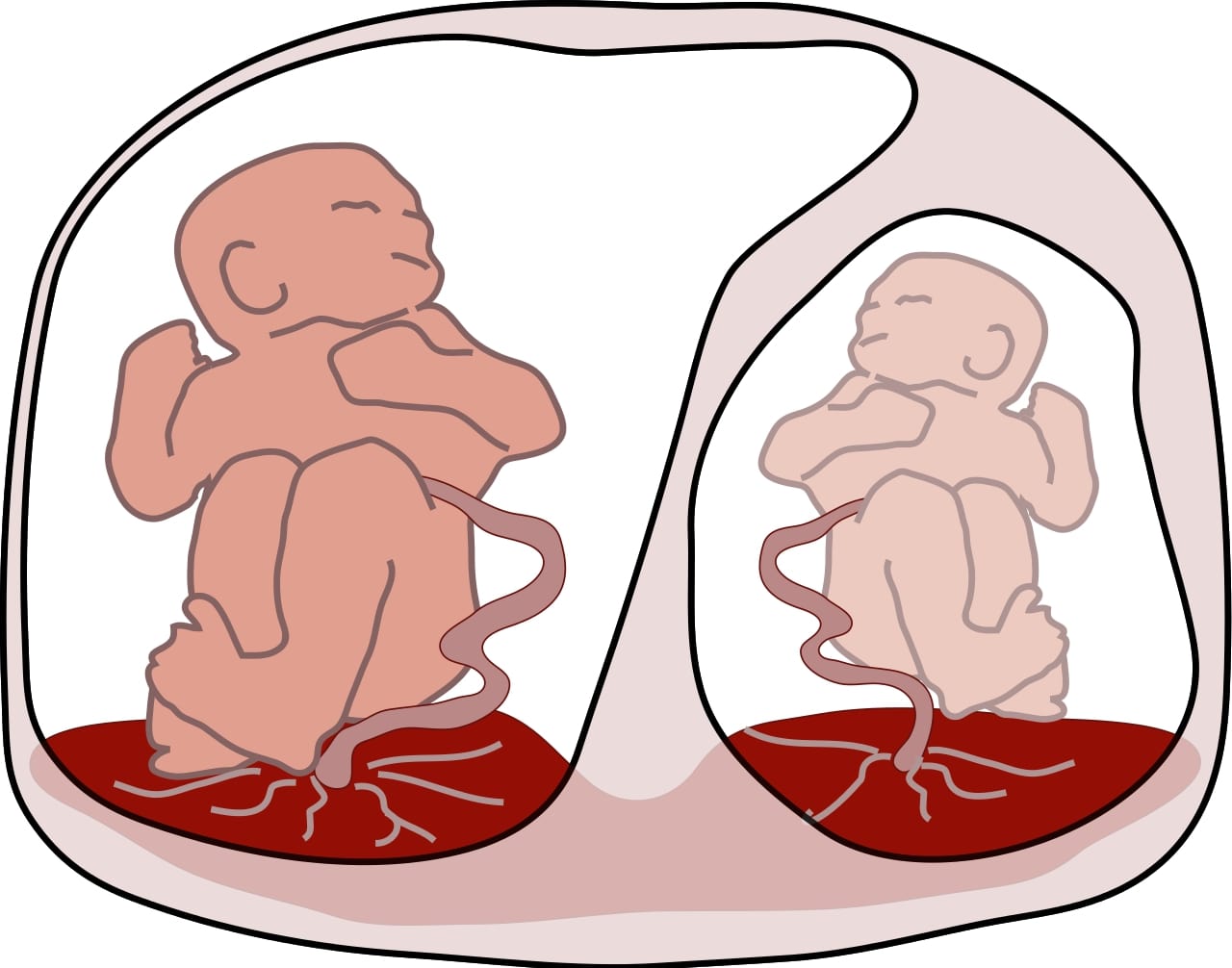Playlist
Show Playlist
Hide Playlist
Multifetal Gestation
-
Slides MultifetalGestation Obstetrics.pdf
-
Download Lecture Overview
00:01 Now we'll discuss multifetal gestation. 00:06 So multifetal gestation pregnancies have increased due to artificial productive technologies such as invitrofertilization. 00:14 The higher the order of multiples meaning twins versus triplets, versus quadruplets, the great the risk of complication. 00:25 So chorionicity. 00:26 There are four different types of chorionicities that we see in pregnancy. 00:29 And it's determine by the day that the division takes place. 00:33 So if the division happens 0 to 4 days after conception, then we have a dichorionic and diamniotic pregnancy. 00:42 So two chorions to amnions. 00:44 If the division takes place 4 to 8 days afterwards, then we have a monochorionic, diamniotic pregnancy. 00:52 So one chorion, two amnion. 00:54 If it happens 8 to 14 days after conception, then we have monochorionic, monoamniotic pregnancy. 01:03 So one chorion, one amnion. 01:05 And then if it happens after 14 days, this is what we see conjoint twins. 01:10 So chorionicity is most easiest to see at the 1st trimester ultrasound. 01:16 And what you're looking for is something called the Lambda sign where you can see the actual division between the two fetuses. 01:23 It's a little difficult to see in the picture here. 01:25 But you can see that thin line that's dividing the two babies there. 01:29 So complications associated with multifetal gestation. 01:33 Again the higher the number of multiples, the great the risk of complications. 01:38 The first is Preterm labor. 01:41 So even as one order multiple such as a twin gestation, there is an increased risk of preterm labor. 01:50 Twin-twin transfusion is common in monochorionic diamniotic. 01:55 And basically what happens is that the recipient twin which is the larger twin, gets more blood flow from the smaller twin which is the donor twin. 02:03 The recipient twin often has polyhydramnios and can actually suffer from high cardiac output. 02:10 And with that they can actually have cardiac failure. 02:13 The donor twin experience is oligohydramnios and is growth restricted. 02:19 Now treatment has evolved over the years. 02:21 Previously delivery was the only option. 02:24 And so often times one twin had to be sacrificed for the other twin. 02:28 But now through fetal surgery we can actually ablate those blood vessels going between the fetuses. 02:33 One of the other complications is fetal growth restriction. 02:37 Because there are multiple fetuses in one uterus, then that can restrict the growth. 02:42 And so each baby is not able to grow to their full potential. 02:46 And then we do find hypertensive disorders also increase with multifetal gestation. 02:52 Hypertensive disorders being gestational hypertension and preeclampsia with either mild or severe features. 03:00 Additional complications that are associated with multifetal gestation are anemia, gestational diabetes, malpresentation, increased need for Cesarean delivery, and postpartum hemorrhage and thromboemolism. 03:13 Because of all these risks, some complications that we discussed, it is recommended that we increase antepartum surveillance during pregnancy. 03:23 So women should undergo ultrasound for fetal growth every 2 to 3 weeks. 03:27 So let's do a case. 03:30 A 26 year old Gravida 1 Para 0 female with a diamniotic-dichorionic twin gestation presents for routine prenatal visit at 35 weeks and 3 days. 03:41 She is concerned about the complications that may be associated with her delivery. 03:46 All of the above are complications of delivery of multifetal gestation except: A. Postpartum hemorrhage B. Preterm birth C. The need for C-section or D. Shoulder dystocia. 04:00 What do you think? The answer is D. 04:04 Shoulder dystocia. 04:05 Multifetal gestation is not associated with shoulder dystocia. 04:09 Definitely there is an increase risk of postpartum hemorrhage because the uterus is distended from the number of fetuses that are in there. 04:15 And that increases the risk for hemorrhage. 04:17 Preterm birth is a risk as we discussed because of the risk of preterm labor. 04:22 And depending on the presentation of the fetuses, very rarely can a vaginal delivery be performed. 04:28 So the need for C-section is increased. 04:30 However, shoulder dystocia that is not an increased risk associated with multifetal gestation.
About the Lecture
The lecture Multifetal Gestation by Veronica Gillispie, MD, MAS, FACOG is from the course Antenatal Care. It contains the following chapters:
- Multifetal Gestation
- Complications Associated with Multifetal Gestation
Included Quiz Questions
If embryonic division occurs 4-8 days from conception, what kind of twins are most likely to develop?
- Monochorionic, diamniotic twins
- Dichorionic, diamniotic twins
- Monochorionic, monoamniotic twins
- Dichorionic, monoamniotic twins
- Conjoined twins
If embryonic division occurs 0-4 days after conception, what kind of twins are most likely to develop?
- Dichorionic, diamniotic twins
- Monochorionic, diamniotic twins
- Monochorionic, monoamniotic twins
- Conjoined twins
- Dichorionic, monoamniotic twins
In a twin-twin transfusion, which of the following is most likely to be seen in the donor twin?
- Fetal growth restriction
- Polyhydramnios
- High cardiac output
- Heart failure
- Liver failure
In which situation is the complication of twin-twin transfusion MOST likely to occur?
- Monochorionic, diamniotic twins
- Monochorionic, monoamniotic twins
- Dichorionic, diamniotic twins
- Conjoined twins
- Twin-twin transfusion is equally likely to occur with all types of twins
Which of the following is not a common complication of multifetal pregnancies?
- Fetal macrosomia
- Post-partum hemorrhage
- Pre-term labor
- Gestational hypertension
- Pre-eclampsia
Customer reviews
5,0 of 5 stars
| 5 Stars |
|
5 |
| 4 Stars |
|
0 |
| 3 Stars |
|
0 |
| 2 Stars |
|
0 |
| 1 Star |
|
0 |




